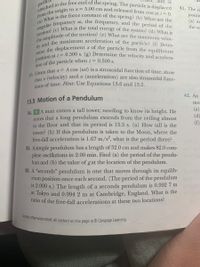Question
35

Transcribed Image Text:tion of the particle when t= 0.500 s.
from the origin to x = 5.00 cm and released from rest at / = 0.
ity and the maximum acceleration of the particle? (f) Deter-
the amplitude of the motion? (e) What are the maximum veloc-
motion? (c) What is the total energy of the system? (d) What is
mine the displacement x of the particle from the equilibrium
Unless otherwise noted, all content on this page is © Cengage Learning.
33. Given that x = A cos (wi) is a sinusoidal function of time, show
angular frequency w, the frequency, and the period of the
(a) What is the force constant of the spring? (b) What are the
attached to the free end of the spring. The particle is displaced
and is
partic
41. The si
positiv
(a) ar
the wa
0.500 s. (g) Determine the velocity and accelera-
position
chat v (velocity) and a (acceleration) are also sinusoidal func-
tions of time. Hint: Use Equations 13.6 and 13.2.
42. An
13.5 Motion of a Pendulum
mo
(a)
(d)
(f)
84. VA man enters a tall tower, needing to know its height. He
notes that a long pendulum extends from the ceiling almost
to the floor and that its period is 15.5 s. (a) How tall is the
tower? (b) If this pendulum is taken to the Moon, where the
free-fall acceleration is 1.67 m/s², what is the period there?
35. A simple pendulum has a length of 52.0 cm and makes 82.0 com-
plete oscillations in 2.00 min. Find (a) the period of the pendu-
lum and (b) the value of gat the location of the pendulum.
36. A “seconds" pendulum is one that moves through its equilib- boo
rium position once each second. (The period of the pendulum leo
is 2.000 s.) The length of a seconds pendulum is 0.992 7 m
at Tokyo and 0.994 2 m at Cambridge, England. What is the
ratio of the free-fall accelerations at these two locations?
Expert Solution
This question has been solved!
Explore an expertly crafted, step-by-step solution for a thorough understanding of key concepts.
This is a popular solution
Trending nowThis is a popular solution!
Step by stepSolved in 2 steps with 3 images

Knowledge Booster
Similar questions
- 23 m/s to km/hr?arrow_forwardA diamond ring was reduced from $699.99 to $499.99. Find the percent reduction in the price. The reduction in price is %.arrow_forwardThe figure shows a two-dimensional vector A. The x-component of A is -10.30 and the y-component is 6.45. What is the magnitude A of this vector? A = Aarrow_forward
- Write the following without a prefix: 689 cm 68.900m 0.689m 689 m 6.89 m 689.000marrow_forwardA car drives for 3.9 hours at a speed of 60.9 miles per hour. What is the distance traveled in meters? 1 mile= 1609.34marrow_forwardAn Egyptian pyramid contains approximately 1.60 million stone blocks. The average weight of each block is 2.35 tons. What is the weight of the pyramid in pounds?arrow_forward
- A jet airplane reaches 884./kmh on a certain flight. How long does it take to cover 227.m ?arrow_forwardaxisarrow_forward13. A railroad car of mass 2.50 X 104 kg is moving with a speed of 4.00 m/s. It collides and couples with three other coupled railroad cars, each of the same mass as the single car and mov- ing in the same direction with an initial speed of 2.00 m/s. (a) What is the speed of the four cars after the collision? (b) What is the decrease in mechanical energy in the collision?arrow_forward
arrow_back_ios
SEE MORE QUESTIONS
arrow_forward_ios